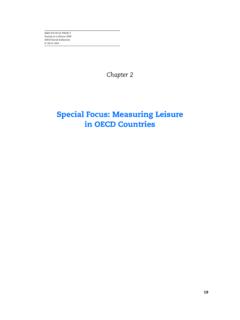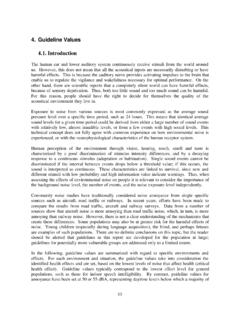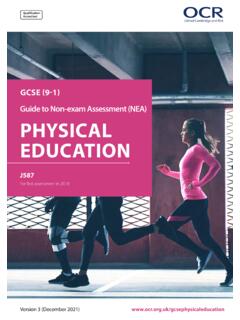Transcription of youth and leisure time activities - World Assembly of Youth
1 Youth and leisure TIME activities WAY REPORT INTRODUCTION The importance of leisure time for young people, particularly as it relates to personal and community development, as well as given a wide range of opportunities for meaningful participation within the community, provided or facilitated by a multitude of organizations, institutions and programs in all sectors. Certain major themes basic health, risk behavior reduction, education, employment and political participation constitute the pillars of Youth policy.
2 Indeed, they are the foundations of human resource development in general, reflecting a continuum of goals from protection to prevention to civic and economic participation. They are the domains of responsibility of the main public systems charged with providing services and opportunities for Youth . They represent the core indicators against which Governments and advocates track progress. They do not, however, represent the totality of young people s lives; herein lays the challenge. In every culture, there are hours in the day when young people are not formally required to be in school or engaged in household or paid work.
3 They choose to be involved in various activities , and there are public and private programs, organizations and individuals who support their participation. These hours, these activities and often even these programs are considered discretionary. They are viewed as optional nice but not necessary, or even particularly important. These are the hours, the activities and the programs whose absence or disappearance would not be noticed by policy makers but would be very much felt by young people.
4 Public recognition of their importance is low, a fact reflected in the scarcity of relevant data. Equally important, it is these hours, activities and programs that policy makers, programed planners and frequently the public have few qualms about reducing. When crime rates go up, the quality and quantity of young people s discretionary hours are often diminished by strict curfews. When test scores drop or family incomes dip, opportunities to participate in voluntary activities are often restricted, as the hours required for work or study are increased.
5 When public funds are low, sports , recreation and cultural programs and institutions are often among the first casualties. In a number of sectors, these hours and activities and the Youth and leisure TIME activities WAY REPORT infrastructure that supports them are seen as promising means to achieve specific, well-defined ends, including delinquency prevention, formal education or HIV/AIDS prevention. Reducing idle time is adopted as a delinquency prevention strategy, Youth counsellors are heralded as effective messengers for reaching peers and family members, and Youth organizations are funded to reach and train young people who have failed in the mainstream educational system.
6 Youth and leisure TIME activities WAY REPORT RESEARCH METHODOLOGY For the purpose of collecting all important data and information required to be processed for establishment of this report-content, secondary data collection is chosen to gather all available information regarding involvement and contribution of Youth in promoting as well as applying a concept of leisure activities in both governmental matter and their daily lives. Different sources ranging from journal papers to published news are used to extract and gather all factual information regarding Youth -involvement in leisure activities .
7 A similar method is also used to gather all responses from various stakeholders towards Youth and leisure activities . The sources are carefully chosen in order to ensure quality of the content, relevance, and ease of comprehension. Reason of choosing secondary data collection is based on a fact that varieties of source are largely available in electronic network. Youth and leisure TIME activities WAY REPORT LITERATURE AND FACTUAL REVIEW FACT-SHEET AND ITS EXPLANATION Fact-Sheet Spending time in everyday family leisure activities is associated with greater emotional bonding within the family.
8 A family s core leisure activities (those that are typically every day, low-cost, home-based activities such as playing board games, playing in the yard, gardening and watching television together) were related to the family s cohesion ( the emotional bonding that family members have toward one another ). Both a family s core activities and their balance activities (those that are novel experiences and require a greater investment of time, effort, planning and money--such as vacations, special events, and sports activities ) were related to the family s ability to adapt Children in families that participate in religious activities together are more likely to report seeing expressions of love and affection between their parents.
9 Two dimensions of family religious involvement family participation in religious activities at least once per week and parental prayer more than once per day were associated with greater expression of love or affection between the parents, as reported by their children. Parents of families in which both the parents and children attend religious services are more likely to know their children s social networks. They are more likely to know their children s friends, those friends parents, and their children s teachers, than parents of families in which only the parents or only the children, or neither, participated in religious activities .
10 Children whose fathers spend time with them doing activities tend to have better academic performance. Preteens whose fathers spent leisure time away from the home (picnics, movies, sports , etc.) with them, shared meals with them, helped with homework or reading, and engaged in other home activities with them earned better grades in school, on average, than peers whose fathers spent less time with them. Similarly, teens whose fathers engaged in activities in the home and outdoors, spent leisure time, and talked with them earned better grades, on average, than teens whose fathers spent less time with them.











